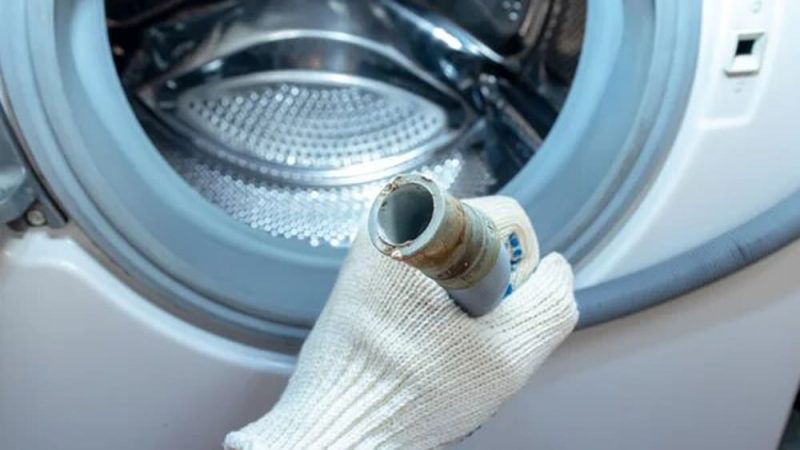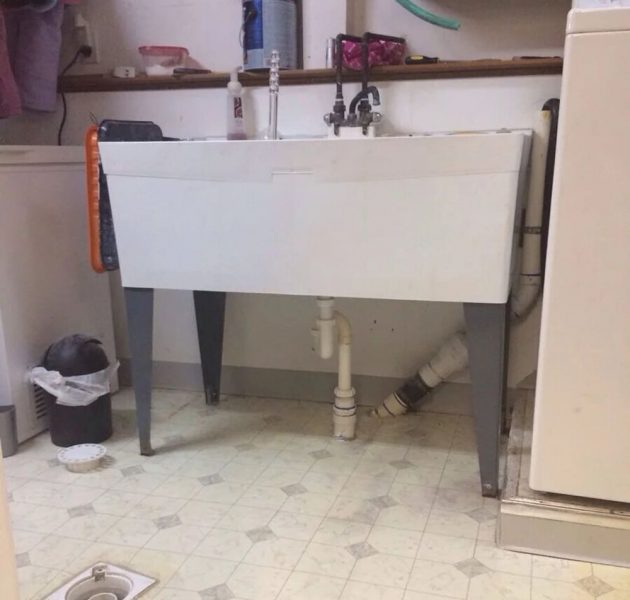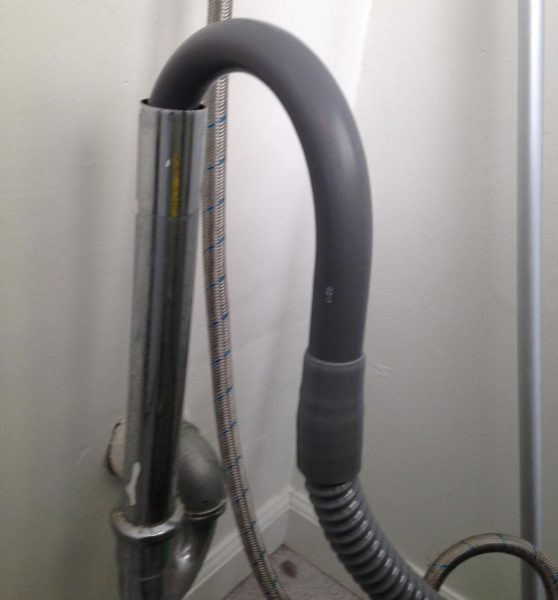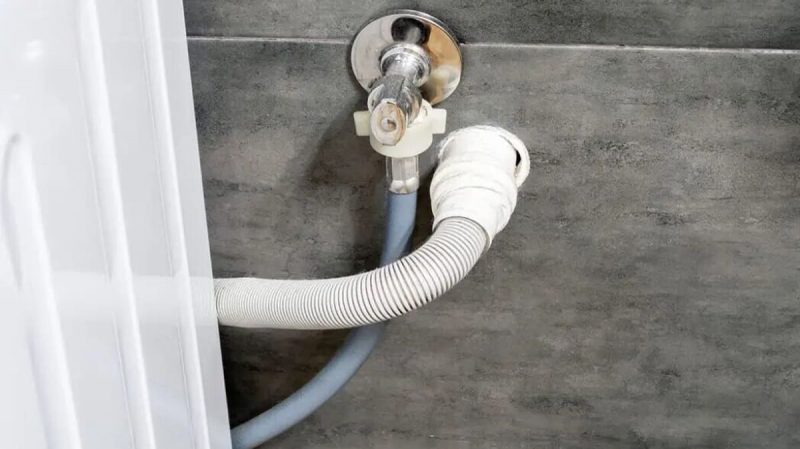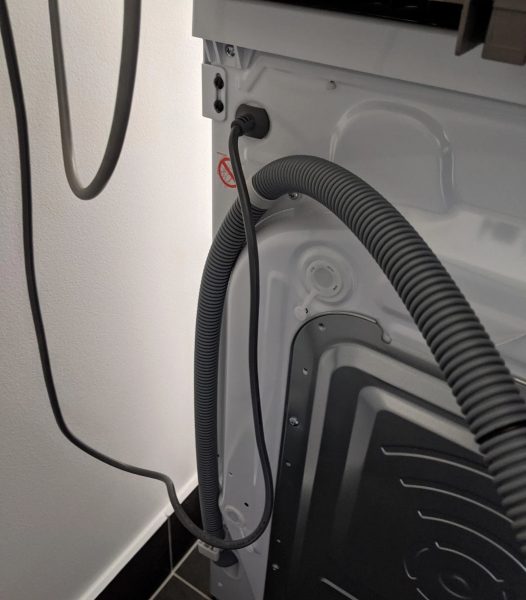When connecting the washing machine, special attention must be paid to the location of the drain hose. Ideally, its end should be at a height of 60 to 100 centimeters.
Such requirements are imposed by manufacturers of household washing machines. But for laundries, this rule does not work. There, on the contrary, the drain must be located above the machine. This minimizes the chance of flooding and overflow.
Where can I drain water and how to eliminate blockages
There are many options in the laundry room where you can drain the water. Consider the most common of them and start with the laundry tank, which is located next to the washing machines.
Washing tank
The hose can simply be thrown over the edge of the tank and fixed with something so that water does not splash. If for some reason the drain there is clogged, you need to check the U-shaped siphon and clean the entire pipeline.
Use a plunger or a drain auger to clear the blockage. The auger is a metal cable with a handle fixed at the end, which must be turned clockwise, as a result of which the cable will move inside the drain, crushing the blockage. Using a plunger is no less effective. With it, you can create the necessary pressure to push through the blockage. Just before that you need to collect a few liters of water.
How to work as a plunger:
- Get plenty of water, take a plunger, install it over the drain hole.
- With up and down movements, begin to move the plunger, creating the necessary pressure in the system.
Water, with force directed to one point, does wonders, and the blockage is removed quite easily. If nothing worked out for you, try another way to remove the blockage – using an auger.
The manual drain auger is effective against blockages. Insert one end of it down, move it back and forth, and then start turning the handle clockwise and counterclockwise.
There is an easier way. If you don’t want to mess around with a plunger and an auger, or you simply don’t have them, send hot water to the sewer or fill in a special solution that copes with blockages. Wait for it to work, then turn on the water pressure. The exact instructions are on the container that contains the solution.
Riser
If the laundry room has a riser, the drain hose can be routed into it. Water will go down the drain, overflowing water will become impossible, unwanted fumes will stop bothering you. If your car is connected to a riser but the water is not draining, look at the drain hose. Most likely there is a blockage. Most often, the drain hose is clogged with clothing fibers. Severe clogging can lead to flooding and damage to the flooring.
How to remove blockage:
- Remove the rubber drain hose, blow it with air. If the air goes badly, then there is a blockage. Rinse the hose with water pressure or clean it with a metal cable, most importantly, do not damage it.
- Buy a new hose and connect to the machine. Use a hose of the same length.
If after the manipulations the machine still does not drain the water, service or replace the pump.
Underground pipe connection
Draining water into an underground pipe is the best option. This is an expensive and labor-intensive way to connect the drain, but the water will directly flow into the waste stack. The likelihood of blockage in this case is minimal. But if, for some reason, underground pipes become clogged, a lot of time will have to be spent on eliminating the blockage, and not only that. Most likely, you will have to hire workers and pay them from personal funds.
If you are planning this option for a drainage device, think about how you will fix the problems. On the other hand, the pipes have a large diameter and in order to clog them, you need to try.
How high will the washing machine pump water?
The height of the drain pipe affects the operation of the pump. Every 30 centimeters of the pipe reduces the pumped volume of water by 4.5 liters. Accordingly, the flow rate slows down.
The optimum pumping speed is 15 gallons per minute. In litres, this is 67.5 litres. Small washing machines can only pump water to a height of about 1 m 50 cm. To ensure proper drainage, your pipe must be at least 1.7 cm in diameter and at least 77 centimetres high.
How to securely fix the drain hose of the washing machine in one place
The drain hose ensures that waste water is removed from the washing machine. Through it, water is delivered to the sink or riser, depending on where it is connected. Reliable fixation of the drainage pipe can be ensured in various ways. In some houses, a small niche built into the wall is used for this purpose. But if not, then other methods must be used. A loose drain hose can cause water to leak out, causing the room to flood. Next, consider 2 mounting options. The choice of one or the other depends on where the water is drained – into the drain pipe or the washing tank.
Buck in the laundry room
Measure the height of the installed tank, it should be no more than 2 meters 43 centimeters. In this case, the water will not start to return back to the washing machine.
One end of the hose must be bent so that it can be placed over the rim of the tank. The distance from the washing machine to the tank is 1 meter 14 centimeters minimum.
To prevent the hose from running away, use a plastic tie. Attach it to the tank leg. The procedure is not complicated. As a last resort, use wire.
Drain pipe
Regarding the drain pipe, first make sure you can secure the hose above the water level in the washing machine. Take the distance from the base of the machine in the range from 2.5 m to 5.5 m. The diameter of a standard drain pipe is about 5 centimeters, it is suitable for most hoses.
The minimum hose length is 0.85 centimeters. If it is located next to a wall, insert its bent end into the drain pipe. Fasten the tie around it so that it is about 15 centimeters below the drain pipe. Screw the bracket into the wall located nearby. If it is made of concrete, use a concrete drill.
If there is no wall nearby, secure the hose to the downpipe with special hose clamps.
Can the drain hose of a washing machine be extended?
Yes, it can be done. On sale there are special extension hoses that can be connected to each other. You can easily lengthen your drain step yourself.
To connect the elements together, use the clamps that come with the kit. The hoses themselves are sold in different lengths. Calculate how much you need and then go to the store.
Before extending the hose, turn off the washing machine and drain the remaining water. In order not to wet the floor, use a bucket or basin.
Why does the washing machine drain overflow?
If the drain is overflowing with water, then there is a blockage somewhere. It needs to be removed. Worse, if a plug has formed in the main sewer line. You will have to try. But the sooner you solve the problem, the sooner you protect yourself from flooding and damage to the flooring.
Start cleaning using the manual auger discussed earlier. Use it to check for the presence or absence of local blockages. If it “walks” unhindered, but the drain is still overflowing, remove the hose, blow or rinse under pressure. After that, proceed to eliminate blockages in other parts of the system.
Usually blockages are not serious, because apart from water and lint from clothes, nothing gets into the drain. The exception is items forgotten in the pockets of things. They can severely clog a hose or pipe, causing flooding. Therefore, before you wash something, do not forget to clean your pockets.
Conclusion
Perform regular maintenance of the drain system. When installing the machine, follow the manufacturer’s instructions. If there is a blockage, use an auger, plunger, or a special tool that dissolves blockages. Unfortunately, there are many products on the market that do not work. So don’t be in a hurry to buy them. First, do a purge with a plunger, it is effective in 90% of cases. If it doesn’t help, start mechanical cleaning with a metal cable. If this does not solve the problem, fill in the product or contact a specialized clog removal service. They have special tools for this purpose.

